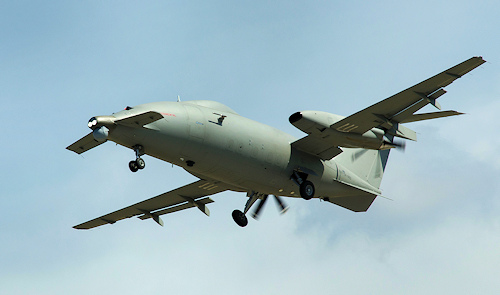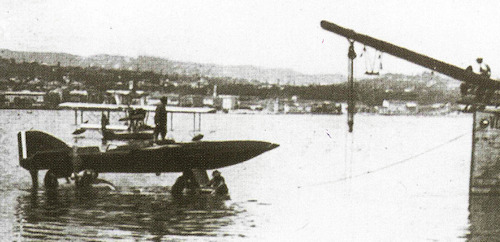While the news about the interest aroused by the Piaggio Aerospace P.180 "EVO" at the European Business Aviation Convention & Exhibition (EBACE) held in Geneva these days are fresh from the press, a press release last week reported the positive outcome of the 'last test for the experimentation of satellite control in long-duration missions at medium altitudes (MALE, Medium Altitude Long Endurance), achieved by the remotely piloted aircraft P.1HH “HammerHead” derived from the P.180.
The objective of this important test was to verify the integration of technologies that allow the remotely piloted aircraft to fly in complete safety in airspace without direct radio signal (BRLOS mode, Beyond Radio Line Of Sight), verifying its performance.
The ground station of P.1HH used the resources of the Athena Fidus satellite, managed by the Space Center of Fucino di Telespazio (joint venture between Leonardo and Thales, respectively to 67 and 33%), for ground-to-ground communication in BRLOS mode. To put it in simple terms, this translates into the ability to transmit the information necessary for flight conduct to the P.1HH in flight and at the same time receive on the ground the data acquired from the sensors and on-board systems of the aircraft, even when communication is not possible direct radio between control center and aircraft.
 P.1HH is a 6 tonne twin-pilot aircraft with remote piloting capable of operating for 10h30 'to 1500 km from the starting base or for total 16h and up to a distance of 4400 nautical miles, at a speed of over 600km / h and capable of higher flight quotas than those of airplanes1: the total reliability of use in conditions of impossibility of direct radio flow (BRLOS, in fact) is a factor no less fundamental than the reliability of its engines and the aerodynamic goodness of the wing.
P.1HH is a 6 tonne twin-pilot aircraft with remote piloting capable of operating for 10h30 'to 1500 km from the starting base or for total 16h and up to a distance of 4400 nautical miles, at a speed of over 600km / h and capable of higher flight quotas than those of airplanes1: the total reliability of use in conditions of impossibility of direct radio flow (BRLOS, in fact) is a factor no less fundamental than the reliability of its engines and the aerodynamic goodness of the wing.
Already last 11 October the P.1HH had carried out the first demonstration in Europe of a complex mission profile for a remotely piloted aircraft. On that occasion, it was successfully simulated the release of a cargo of essential goods (medicines, foodstuffs) followed by the landing in automatic mode (ATOL) in a location without assistance on the fly, exploring all the possible scenarios of employment that the this machine can offer both in normal and emergency conditions.
Our effort to make certain technical details more comprehensible is to make it clear that the successes achieved in this type of test place the Italian aerospace industry (and in this case Piaggio Aerospace and its partner companies) in a leading position compared to the others European and world countries.
 True, the ownership of Piaggio Aerospace has not been Italian for years, but offers work on Italian soil to several hundred employees, thus generating a certain "induced". Beyond that, historical and cultural belonging remains ours.
True, the ownership of Piaggio Aerospace has not been Italian for years, but offers work on Italian soil to several hundred employees, thus generating a certain "induced". Beyond that, historical and cultural belonging remains ours.
It seems to us, therefore, that such a success is worthy of a bit 'of notoriety more.
That the Piaggio Aerospace is a pioneering and avant-garde company, is perhaps not known to all because its reserved and sober image hides a very long story, well begun 134 years ago.
Founded in 1884, (5 years before FIAT) for production of naval fittings and railway carriages, it has started developing its aircraft since 1915. These were immediately characterized by innovative and courageous design choices, always in great anticipation on the "competitors".
Until the diffusion of P.180 "Avanti", this pioneering spirit has often been paid dearly, with huge investments for the realization of innovative prototypes of great hope, not always successful.
 Some examples :
Some examples :
- P.7 (hydrofoil hydrofoil to the Scheneider Cup),
- the P.8 (reconnaissance transportable in submarine and mountable in less than half an hour),
- the P.108A (anti-ship flying gun cannon equipped with 102mm cannon)
they are all prototypes entered in the history of aviation as aircraft that would have outclassed any competitor, if their diffusion had not been hindered by particular historical adversities or by the prejudice of potential buyers to peculiar characteristics that are too innovative.
Evidently, the individual genius of the Piaggio designers outclassed the general culture of the period and the bitter lesson learned in the Ligurian company led them to international success in the collaborations they had later, with other builders where they developed less innovative and daring projects.
 Two examples for everyone. The first is that of Eng. Corradino d'Ascanio: he was the real father of the helicopter as we know him today, but his notoriety is more tied to the idea of the Vespa scooter, which he built in the same plant in Pontedera from which he flew between the 1939 and the 1952 four helicopter prototypes (thus exploring the experimentation of all the solutions seen later for the rotary wing) until the heirs of the sen. Rinaldo Piaggio divided the company into the two branches of aeronautics and motor vehicles. Yet, in the collective imagination, the Italian name associated with the helicopter is that of Count Giovanni Agusta, while the brilliant D'Ascanio rarely goes beyond the association to the "Vespa"!
Two examples for everyone. The first is that of Eng. Corradino d'Ascanio: he was the real father of the helicopter as we know him today, but his notoriety is more tied to the idea of the Vespa scooter, which he built in the same plant in Pontedera from which he flew between the 1939 and the 1952 four helicopter prototypes (thus exploring the experimentation of all the solutions seen later for the rotary wing) until the heirs of the sen. Rinaldo Piaggio divided the company into the two branches of aeronautics and motor vehicles. Yet, in the collective imagination, the Italian name associated with the helicopter is that of Count Giovanni Agusta, while the brilliant D'Ascanio rarely goes beyond the association to the "Vespa"!
The second example is that of Eng. Giuseppe Gabrielli: in his activity at "Piaggio & C." developed an innovative (metallic and improved) reinterpretation of the glorious SIAI Marchetti S55 seaplane with results that aroused the admiration of those who designed the original wooden version. Unfortunately, the "metallic" S55 did not go beyond the prototype, while all FIAT aircraft signed by Gabrielli's "G" have been sold all over the world in thousands of specimens, including the G91 fighter which for some (wrongly) is a “pantographed” F-86E…!
Being innovative means having to do a lot of research and development with consequent high costs and difficult to recover.
Thus, even the effort to be equipped with the first Italian civil aerodynamic gallery and to have developed the ability to design and build propellers and engines on their own has perhaps subtracted more resources than it has made.
An effort that has reached the apex with the development of the PD-808, which to date is still the first and only jet aircraft for passenger transport entirely made in Italy, moreover with criteria from a scheduled airplane and not light birver.
The aeronautical production at the Genoa-Sestri Ponente, Finale Ligure, Pontedera and Marina di Pisa plants has therefore often been maintained through production under license (which allows for useful design and technological comparisons): from Farman to Caproni, up to Dornier Do 18 " Wal ", Cant-Z 506, Reggiane 2002 and FN-305. All magnificent airplanes, but developed by others.
 The successes of some "autochthonous" products such as aircraft were certainly not lacking:
The successes of some "autochthonous" products such as aircraft were certainly not lacking:
- P.108B (considered better than the American B17 contemporaries),
- P.148 and P.149 (also sold in Germany and produced under license by Focke Wulf)
- P.136 (appreciated by VIPs such as Onassis, for their amphibious and transportable characteristics on yachts)
- P.166 (even sold to Northrop for their business transport needs).
Also the Piaggio engines and propellers allowed appreciations and records, such as the one for the Gen. SA share Mario Pezzi (over 17000m, undefeated by 1938) obtained thanks to a Piaggio quad propeller, specific for the high altitude.
Something of this long history can also be found in the current "Piaggio Aerospace".
Today, in fact, the Ligurian company produces, under license, components of Rolls Royce, Honeywell and Pratt & Whitney Canada airliners of great diffusion alongside its aircraft, takes care of the final assembly, tests and maintenance.
Which aircraft do these engines use?

Having gained a great experience sooner or later repays.
With this in mind, the path started to produce the PD-808 and continued with the P.180 today allows the Piaggio Aerospace to offer 2 highly advanced fixed-wing product lines that are flanked by the already mentioned licensed engine production.
 The first product line is intended for the civil market and consists of the current "EVO" version of P.180: a biturboelica for businessmen or air ambulance.
The first product line is intended for the civil market and consists of the current "EVO" version of P.180: a biturboelica for businessmen or air ambulance.
Performance comparable to a jet for comfort and performance, but with lower operating costs than 30% have made it a successful aircraft in the "executive" aviation market worldwide.
An aircraft that since its first appearance in the mid-'80, aroused the interest of the Gates-Learjet, which already in the name is identified with a certain type of propulsion that denies the propeller and that years before with its Lear 23 -24-25 saturated the possible market of the PD-808.
The current product line for the military market is given by two aircraft: the MPA multi-role plant and the P.1HH "HammerHead" with which we have opened this article.
Of P.1HH "HammerHead" we therefore limit ourselves to remembering that, being a remote piloted aerial system (Unmanned Aerial System), it is composed not only of a remotely piloted aircraft (UAV), of a Ground Control Station and of integrated systems navigation and mission.
 Regarding the MPA multirole aircraft, it can be concluded by saying that it is the natural rational evolution of P.166-DL3 for decades used in FFAA for air surveillance missions, land, coastal and maritime patrols. In short, it is the most performing and economic platform of P.180, adequately modified, to continue the task of P.166-DL3.
Regarding the MPA multirole aircraft, it can be concluded by saying that it is the natural rational evolution of P.166-DL3 for decades used in FFAA for air surveillance missions, land, coastal and maritime patrols. In short, it is the most performing and economic platform of P.180, adequately modified, to continue the task of P.166-DL3.
The diffusion already achieved worldwide in the civil market by P.180 offers simpler assumptions of logistical assistance to the Piaggio Aerospace product line destined for the military market.
Similarly, when in future there will be civil aircrafts for remotely piloted aircraft, the experience gained on P.1HH will be able to pour into the civil market, making available immediately a valid and tested product for civil commercial scenarios, today futuristic but not completely ... air!
To reward the patience of those who have had the consistency of reading so far, we can only delight in the images of the amazing acrobatic abilities of P.180, visible in this movie (v.link).
(Click here to download the article in pdf)

1 Source: brochure P.1HH HummerHead Piaggio Aerospace
(photo: PIAGGIO AERO INDUSTRIES / web)












